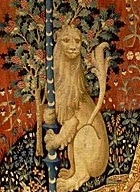For those of us with hearing loss, reminders are everywhere of what we may be missing —the joy of music or speech, for example, if only we could hear well enough to make sense of them. Yet sometimes, unexpectedly, we receive messages from unusual sources that tell us that our senses are intertwined, helping us to enjoy what we thought had been lost.
My friend Ken Marion, a delightful man I met at the 2015 Hearing Loss Association of America Convention, is an enthusiastic patron of the arts. He recently visited France, including Paris and Normandy. (Note: ‘HoH’ is a slang term meaning a person with hearing loss.)
by Ken Marion
Traveling as a HoH in a foreign country can be complicated and it can have its sad moments. Paris, which I recently visited, is a beautiful city with much to offer although not always so much for people with hearing loss. In my six day days in Paris and two days in Normandy, I encountered only one hearing loop (in Normandy). It didn’t seem to be working and the staff didn’t have a clue on how to fix the situation.
But visually, Paris is fascinating, filled with museums and historical sites. The Louvre offers some the world’s most beautiful and moving artistic creations. Mont Saint Michel, Sainte-Chapelle, the Conciergerie and so much else bring history alive for me.
At the Cluny, a museum dedicated to the medieval period, I viewed the extraordinary five hundred year-old tapestries La Dame à la Licorne (The Lady and the Unicorn), woven in wool and silk in Flanders. There are six tapestries, five of which illuminate the five senses.
In the tapestry depicting “hearing”, the lady stands on one side of a portative organ while a handmaiden pumps the bellows on the other side. One of the many significant parts of this image is that the unicorn appears to be lying down, the only time in the five tapestries that he seems at rest. This struck me directly in the heart. Music soothes…..

The small book on the tapestries produced by the Museum reads “The sounds which flatter our HEARING travel and vibrate for man’s pleasure. Unfortunately, they can dissolve into cacophony and perturb the silence which, itself imperturbable, remains golden except when, tamed by music, it is eternal enjoyment.”
I’ve been lucky to lose my hearing slowly enough to have had the full benefit of the feelings brought alive by music. It is now harder for me to hear the higher registers or with clarity even with my hearing aids. The tapestry brought this into focus. The tapestry reminded me as well of the huge number of people who have never heard music or have completely lost the ability.
Ballet choreographer George Balanchine said, “It’s about the music”. He built his ballets upon the foundation of musical notes that the lady and the unicorn both hear. The music in this tapestry is clearly restful to the unicorn, it is work for the handmaiden, it is art for the lady, and it is something so many of us cannot enjoy to the fullest.
But our eyes take in the beauty of these tapestries. And there are moments, such as at the ballet, when if we can’t hear the music well, we can feel it with our eyes and our bodies as the music fills the theatre around us with pulsations.
Image of the La Dame à la Licorne at the Paris Musée de Cluny
 Ken Marion has his own blog about growing up in New York in the 50’s.
Ken Marion has his own blog about growing up in New York in the 50’s.







